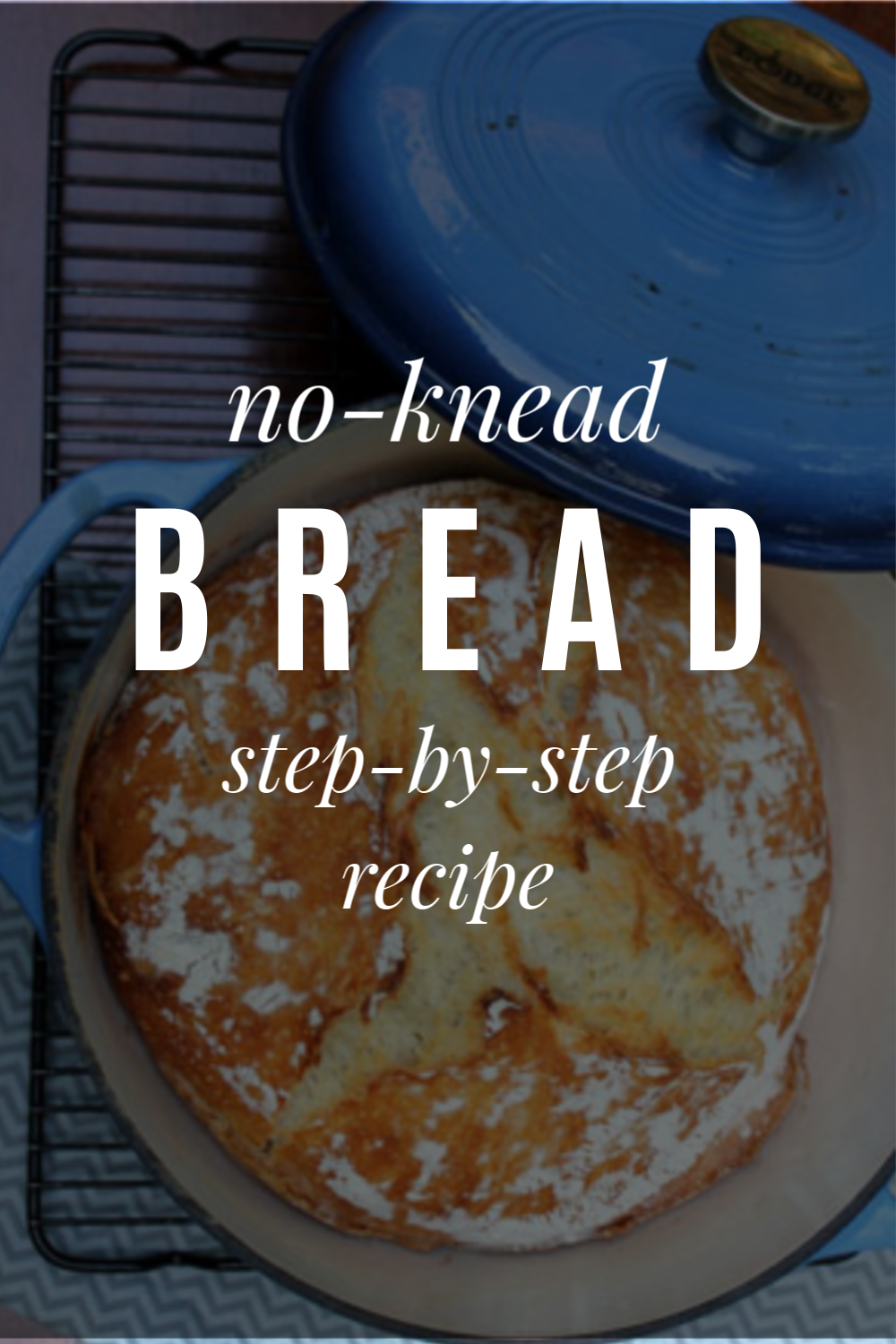
No-Knead Bread Recipe
If you have been hanging out around Frugal Living NW for awhile, you know that I am a big believer in making food from scratch at home. With a few exceptions, I prefer creating something in my own kitchen to buying it in the grocery store.
Bread can be tricky, though. There is some stiff competition out there, and it is tough to replicate a commercial oven’s heat and steam in a normal home kitchen.
For the last several years, I thought that Artisan Bread in 5 Minutes was the best thing since, well, sliced bread. It was simple, and we were content with the results. That is, until last summer when our neighbor brought over a beautiful, delicious loaf of home-baked bread. We had to know her secret. One phone call, and she came back with the book, My Bread by Jim Lahey (Amazon).
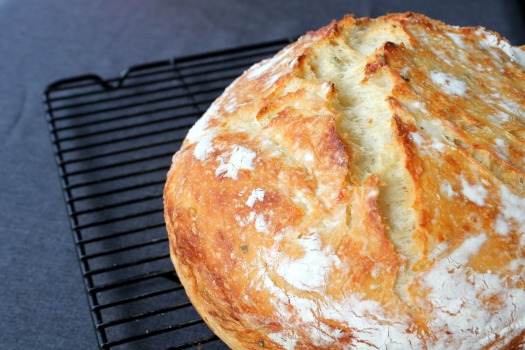
We have been baking bread using this method ever since. I can count on one hand the number of times I have bought bread in the store since then, because I can now make an artisan-quality loaf at home for a fraction of the cost.
I am telling you, this is consistently the best bread I have ever made in my kitchen. Okay, enough gushing. Let’s make some bread.
The only changes I have made to Lahey’s method is to double the amounts and adjust the baking time and temperature to achieve a bigger loaf with a thinner crust.
Oh, and don’t be put off by all these steps. This is totally possible for home bakers at any skill level. I wanted to give you the confidence to do this on your own. A concise recipe can be found at the bottom of this post.
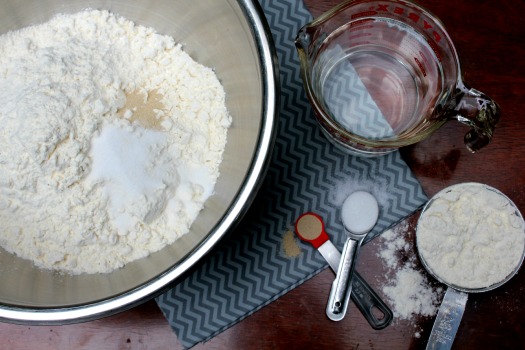
The ingredients are simple: flour, water, salt, and yeast. My husband calculated this bread costs 74¢ per loaf (using Bob’s Red Mill flour & Costco yeast).
Oh, wait! Don’t forget to factor in the roughly 8 cents of energy used to bake it for an hour. No, I’m serious. My husband really does think about this stuff! He’s funny.
So, there you go. A whopping 81¢ for a substantial 2.5 pound loaf of bread. That is crazy cheap.
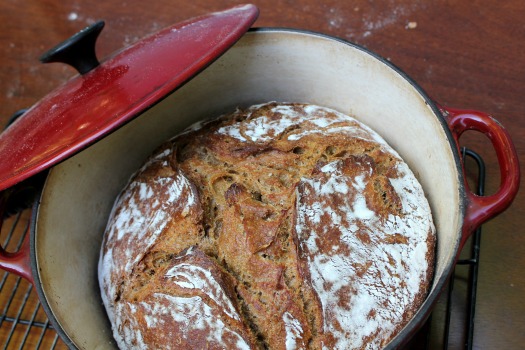
If you want to use some whole wheat flour, substitute 3 cups of whole wheat for 3 cups of the all-purpose flour (3 cups whole wheat and 3 cups of unbleached flour for a total of 6 cups) and add 3 Tablespoons of molasses (optional). This will produce a slightly sweeter, denser loaf of bread. Delicious.
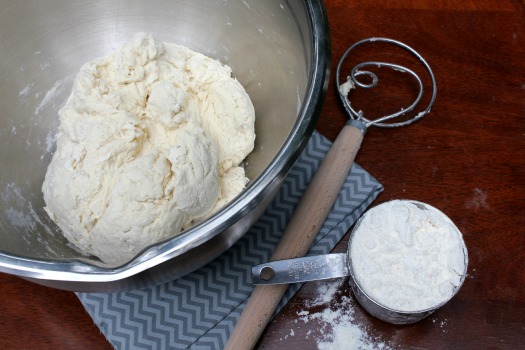
Combine the dry ingredients, add the water, and stir to combine (the funky looking wood-handled item is the amazing Danish Dough Wisk — makes stirring stiff dough a snap). The dough should be wet and sticky. Depending on the temperature and humidity in your home, you may need to add a little more flour or water, 1 Tablespoon at a time. So far, these steps are exactly the same as the 5 Minute method.
The main differences are that you use significantly less yeast (1/2 teaspoon vs. 1 1/2 Tablespoons) and significantly more initial rise time (12-18 hours vs. 2 hours).
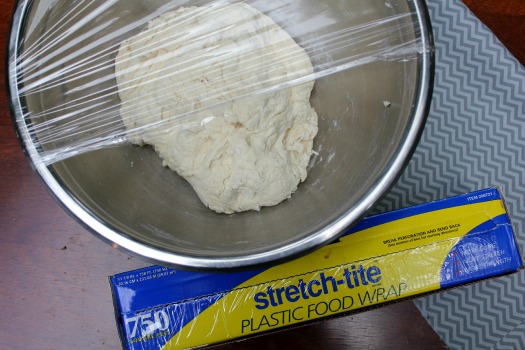
Once the ingredients are completely combined, cover the bowl with plastic wrap and leave it on the counter to rise for 12-18 hours. This slow rise aids in the fermentation of the yeast, giving the bread a better flavor.
Okay, I know what some of you are thinking: 12-18 hours! That’s ridiculous! Who has that kind of time?! I get it.
However, here are two things to consider:
- Once you get into a rhythm of baking your own bread, it’s not a big deal. I start mine in the afternoon or evening and bake it the next morning or afternoon. This would also be an easy weekend routine.
- Just like the title claims, this bread requires no kneading. It is not fussy, temperamental dough. You can produce a delicious loaf of bread with very little hands-on effort & experience.
You’ll know your dough is ready when it has risen in the bowl, smells yeasty, darkened slightly, and is covered with small bubbles.
Using well floured hands, shape and tuck the sticky dough into a rough ball. You can also fold it over a couple times on a well-floured surface. It doesn’t have to be perfect; just keep quickly tucking the dough underneath with your fingertips until you have a semi-smooth dough ball. The dough should be wet but manageable; you don’t want a wet blob so sticky that you can’t shape it into a ball.
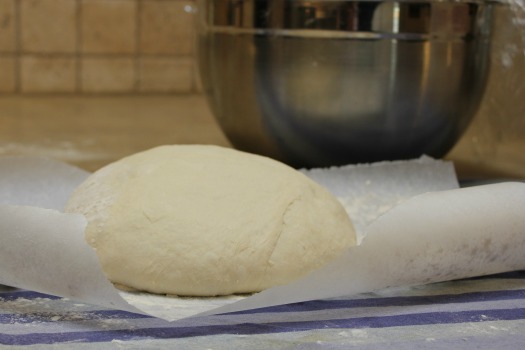
Take a clean linen or cotton tea towel (not terry cloth) and dust it with flour, cornmeal, or wheat germ to prevent the dough from sticking to the towel as it rises. You can also use a floured square of parchment paper on the towel to make the dough ball easier to handle. Place the dough ball, seam side down, in the middle and dust with more flour.
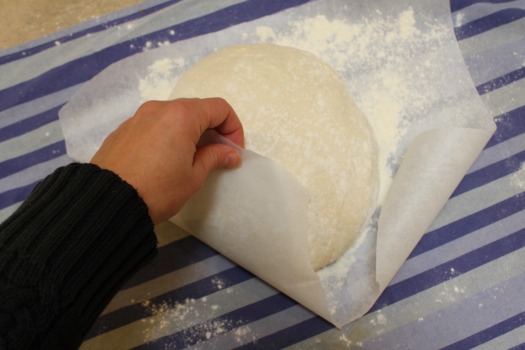
Cover the dough with the (parchment paper and) towel and let it rise for 1-2 hours at room temperature, until doubled in size. During the last 30 minutes of rise time, place a heavy lidded 6-8 quart pot, like a Dutch oven, in a cold oven and preheat it to 425 degrees.
Confession: I own three Dutch Ovens. I use them all the time. They are incredibly versatile and worth the investment. If you don’t own one, you could also make this in any lidded pot, provided it is oven-safe at such high temperatures. Also, check the knob on your pot. If it isn’t rated for such high heat, you’ll want to remove it or cover it with foil. You can also buy an inexpensive replacement knob that is rated for higher temps!
Okay, this is the trickiest part of the entire operation. Remove the lid from the piping hot Dutch Oven, slide your hand underneath the towel or parchment paper, and flip the risen dough (seam side up now) into the pot. Try to flip close to the pot or the flour will fly everywhere. Remove the towel or paper and set aside.
This might take a bit of practice, but again it doesn’t have to be perfect. Some of my worst flips have produced my most beautiful loaves. I love what Lahey writes, “…even the loaves that aren’t what you’d regard as perfect are way better than fine.”
Place the lid back on top and slide the pot back into the hot oven.
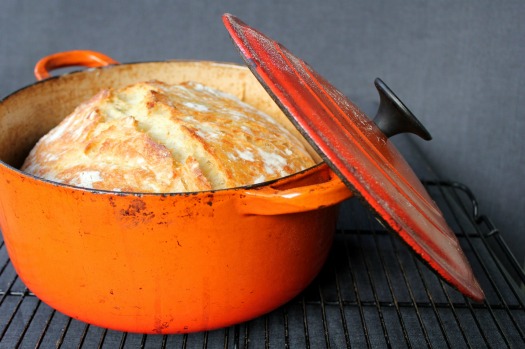
Bake it for 40-50 minutes. Remove the lid. Bake for another 5-10 minutes, until golden chestnut brown. The internal temperature should be around 200 degrees. You can check this with a meat thermometer if you’re nervous about knowing when your loaf is done.
Oh man, your house will smell so good about right now.
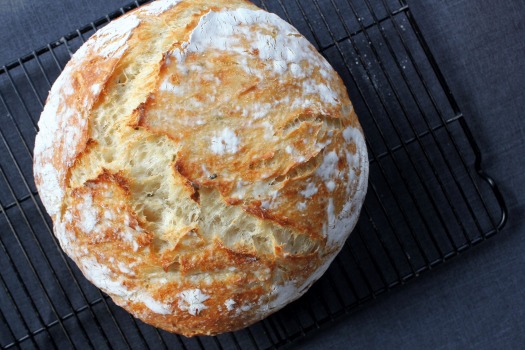
Place the loaf on a cooling rack. You will hear it crackling as it cools. Use every ounce of self-control to resist cutting into it until it is “quiet”; cutting it too soon will make the bread dense and gummy.
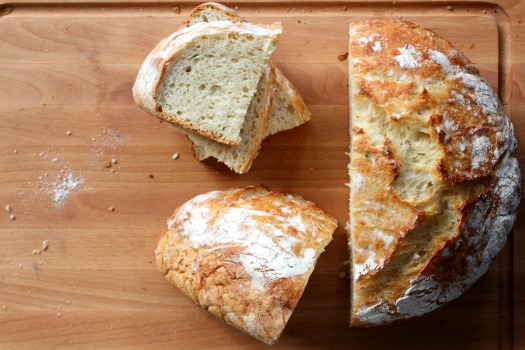
This bread is best the first 2-3 days. I just store my leftover loaf inside the Dutch oven on the countertop. Using plastic wrap will soften the crust. Dry, leftover bread makes great bread crumbs, toast, French toast, or croutons!
Enjoy. And pat yourself on the back. You just baked an amazing loaf of bread!
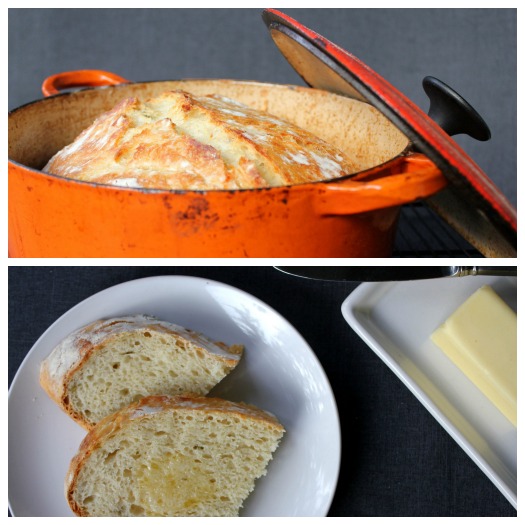
Basic No-Knead Bread
Slightly adapted from Jim Lahey’s My Bread
Ingredients
6 cups bread flour (recommended) or all-purpose flour, plus more for work surface
1/2 t. instant or active-dry yeast
2 1/2 t. salt
2 2/3 c. cool water
- In a large bowl, combine the flour, yeast, and salt. Add the water and stir until all the ingredients are well incorporated; the dough should be wet and sticky. Cover the bowl with plastic wrap. Let the dough rest 12-18 hours on the counter at room temperature. When surface of the risen dough has darkened slightly, smells yeasty, and is dotted with bubbles, it is ready.
- Lightly flour your hands and a work surface. Place dough on work surface and sprinkle with more flour. Fold the dough over on itself once or twice and, using floured fingers, tuck the dough underneath to form a rough ball.
- Place a full sheet/large rectangle of parchment paper on a cotton towel and dust it with enough flour, cornmeal, or wheat bran to prevent the dough from sticking to the parchment paper as it rises; place dough seam side down on the parchment paper and dust with more flour, cornmeal, or wheat bran. Pull the corners of parchment paper around the loaf, wrapping it completely. Do the same with the towel. Let rise for about 2 hours, until it has doubled in size.
- After about 1 1/2 hours, preheat oven to 425 degrees. Place a 6-8 quart heavy covered pot, such as a cast-iron Dutch oven, in the oven as it heats. When the dough has fully risen, carefully remove pot from oven. Unwrap the towel and parchment paper from around the dough and slide your hand under the bottom of the dough ball; flip the dough over into pot, seam side up. Pull the parchment paper off, scraping any stuck dough into the pan. Shake pan once or twice if dough looks unevenly distributed; it will straighten out as it bakes.
- Cover and bake for 40 minutes. Uncover and continue baking for 10-15 more minutes, until the crust is a deep chestnut brown. The internal temperature of the bread should be around 200 degrees. You can check this with a meat thermometer, if desired.
- Remove the bread from the pot and let it cool completely on a wire rack before slicing.
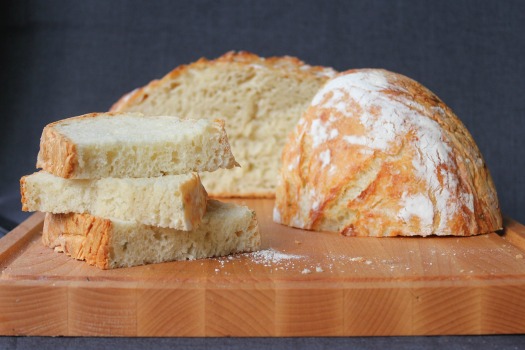
Here are a couple options for Dutch Ovens. Any heavy, lidded 5-8 quart pot (seasoned cast iron or enamel coated) would work with this recipe. Lodge has the best prices/options for dutch ovens on Amazon.
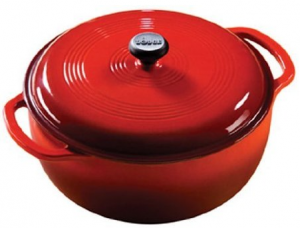
Lodge Logic Dutch Oven in Island Spice Red (6 Quart)
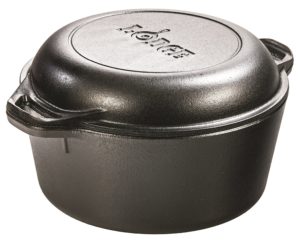
Lodge Cast Iron Double Dutch Oven (5 Quart)
If you already have a dutch oven (or find a deal on a lesser-known brand) that doesn’t have a knob rated for high temps, replace it! There are some really affordable options.
Got questions? You are in good company. Go here for the complete FAQ list.
Looking for more variations to the no-knead bread recipe? We’ve created a list with sweet and savory varieties, including the following:
- Cranberry Orange
- Four Cheese
- Sandwich Bread
- Dark Chocolate Coconut
- Tomato Basil Cheese
- Whole Wheat
Looking for more delicious bread recipes?
Find more delicious recipes on our Recipe Page!
Follow Frugal Living NW on Pinterest!
Fantastic range of boards from best recipes and tips for frugal living to gardening and budgeting help.
This post may contain affiliate links. See the disclosure policy for more information.
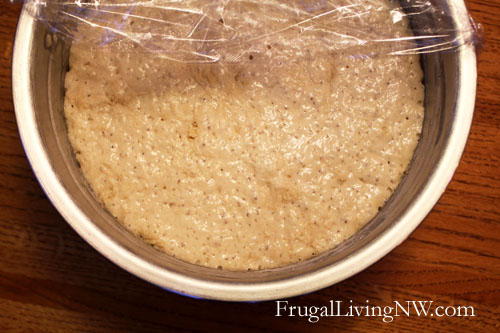
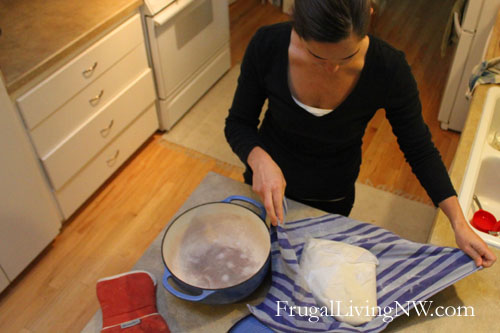
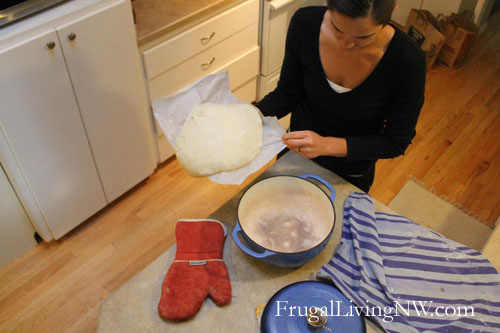

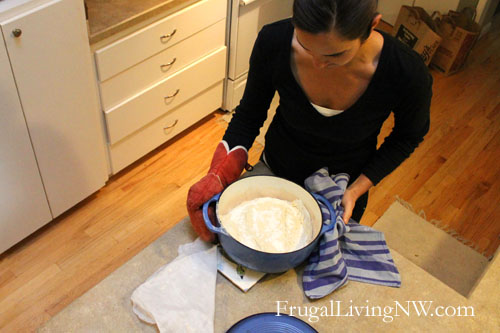
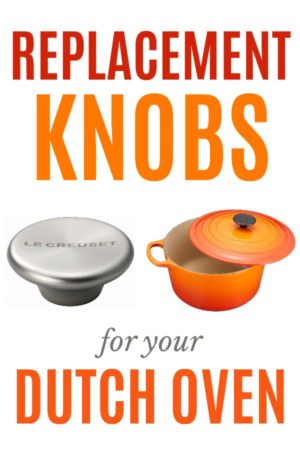

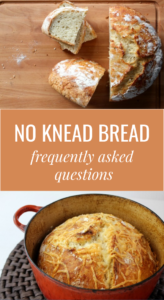
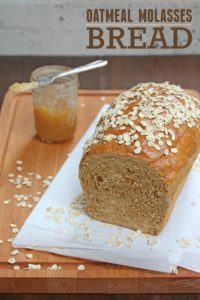
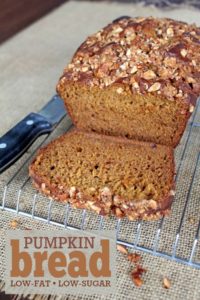
Okay, I confess that I did not read the very very long page full of comments on this post. Please forgive me and just direct me to do so if this has already been answered.
Has anybody tried converting this to sourdough? I just don’t see buying yeast at the store when I can grow it myself and get [what I think is] a tastier bread at the same time.
I just baked my first Dutch oven loaf (actually in a vintage Revere stainless 8-quart pot) tonight. It is amazing, but it stuck a bit, so I went looking for suggestions to prevent sticking and found this page. The recipe I used (from the King Arthur Flour site) uses a slightly different method, though: the dough is transferred to the oiled (cold) Dutch oven to rise after the initial proofing, then placed in a cold oven turned to 450, baked, then lid removed and then baked longer until browned. I must say I’m fonder of that than of the thought of trying to transfer a sticky mass of dough to a searing hot pot. (I absolutely *WILL* burn myself more than once if I try that.) So I’m also curious if anybody’s tried that method.
Here are some reader comments regarding sourdough:
From Carlota: Mixing subsequent batches into the old container without washing it will encourage a sourdough. After a while it will be slightly pungent and the recognizable sourdough smell.
From Diana: I make this recipe, sourdough all the time. I use my sourdough starter instead of yeast in this recipe and it come out beautifully… What I have read and feel it true is, use less starter for stronger sourdough (it will take a bit longer to rise but the sourness does increase.) I normally add about 1/2 cup….my recommendation is play with the amounts (My sourdough start is the live culture in my fridge that you feed every once in a while and will rise bread off the live culture (I am not sure if this is what you have, if you have the powder I am unsure how to use)….
From Jules: The cheapest good way to get started making sourdough is to get some starter from a friend who has a really good one.
The best but not necessarily cheapest way I know to *make* a sourdough starter is to start with half rye flour and half water, one cup each, and leave it out for a couple of days in a warm, draft-free place, covered with a damp cloth (you have to keep re-dampening), until yeast colonizes it. If you’re unlucky, you may have to do this a couple of times to get a palatable starter. If you bake bread regularly in your kitchen, you should be okay. You have to stir your beginning starter every day, and your glass or ceramic container for it should be more than twice as big as your starter, because your starter will more than double every time it gets bubbly.
After it’s colonized, you keep it in the fridge, stir it down every day or two, yada yada yada. I’m sure there are good instructions online.
Each week when you feed your sourdough starter, you want to feed it with the rye flour until you run out of rye. Then you can switch to feeding it with white flour or whole wheat flour.
The reason it may be worth the extra money is that rye colonizes well with wild yeast, and it develops complex flavors with various wild yeasts really well. It’s easier to maintain a great sourdough yeast culture than it is to get one started in the first place.
Starting with either a small bag of rye flour (reduce total outlay) or a larger bag of rye flour (extend time the new starter is rye-fed) can go under the heading of doing it right instead of doing it over. You want to get a good, rich sourdough taste the first time you try to make a starter. You don’t want to have to throw your attempt at a starter out and try again, or have a starter that is just bland and doesn’t give you the flavor notes you could have gotten with a good beginning.
Thanks a great post! thanks so much. I had a friend years ago that made the best rye sourdough and I just have to try it myself!
Get oven gloves. There are many types including huge silicone for BBQ.
http://smile.amazon.com/Oven-Gloves-Resistant-Light-Weight-Potholders/dp/B00CHO64NE/ref=sr_1_9?ie=UTF8&qid=1430867929&sr=8-9&keywords=barbeque+gloves
I tried this in a stainless stock pot and came perfect! I didn’t let rise the second time, even, as I was pushed for time. Thanks so much for this recipe! Wish I could attach a photo!
Made my first loaf, by the recipe, over the weekend. OH MY!!! So good. Tried another loaf today. 3 cups ground oat meal, 3 cups white floor. Same temp, length of time. Very good. I’ll continue to experience with the other suggestions and using whole wheat. So happy that I found this recipe.
ok…for us low carbers….will this recipe work with almond flour???
that would be totally awesome if it did
thanks
Sorry, this won’t work with almond flour- Almond flour has no gluten, making most yeasted breads pretty impossible with all almond flour. You might be able to substitute some almond flour, but not the whole loaf.
So, this is my first time making anything involving yeast…do you have to activate the yeast before you put it in?
Nope! Just add & mix the ingredients exactly as written and you’ll be good! This is a great recipe for first-time bread bakers! Let us know how it turns out.
I just made this bread in a stainless steel stockpot of all things. It cooks evenly came out without any sticking works like a charm.
When I make this, I do the rising in a huge bowl that is sprayed with PAM and then cover it with plastic wrap that is also sprayed. When it’s time to put it in the dutch oven, I take off the plastic, turn the bowl over to dump it in the pan. Let it rise again and bake. No mess at all!!
You know, I gave up and dumped it in the bowl. When I went to dump it in the pot, it about just slid out fine. So I am going to try this when I get over the trauma–lol!
I am sweating. What a mess! How come your towels look so clean? ?? Really, my kitchen is disaster city and half the loaf went down the drain just trying to get this stuff off of my hands. And those towels? I don’t know what I’m going to do with those!
Tell me I’m doing something wrong. Because this is my second loaf and it is really, really delicious bread!
If you look at the step-by-step pictures, I actually use a layer of parchment paper in between my dough & towel now. So much easier! I’ve updated the directions to reflect this.
Hope this trick helps keep your future loaves/towels neater! (Also, if you read through the comments there are tons of variations to the rise and/or flip suggested by readers!)
I don’t have an enamel or cast iron pot but I have a large stainless steel pot and a pampered chef stone baker (9×13 with stoneware lid). Suggestions for which to try? Happy to buy a real Dutch oven if I can make this beautiful bread but would like to try my hand at it first before spending the money as I haven’t found a need for one at other times. Thank you!!!
Also, can I mix and let this rise in a plastic bowl?
Christine,
The stoneware may work. What I use is the crock from an old crockpot I found at the dollar store. I like it because it makes a round loaf and it’s the perfect size. Good luck. I’m sure you will love this recipe.
Brilliant!
Someone asked about wrapping the bread for a gift so as not to soften the crust. I wrap in a pretty dishtowel from the dollar store.
I am planning on making some as gifts and was curious about the best way to wrap this without making the crust go soft.
The bread makes a great gift. I buy the plain brown roll of wrapping paper (at the Dollar Store) and I wrap the cooled bread in that and tie it with baker’s string. I’ve also bought tea towels at the Dollar Store too. Both are very cute and it’s a great gift. Sometimes I bring some homemade butter with it (or you can cheat and put butter into a cute dish) and sometimes I give it with Trader Joe’s bruschetta!!! I hope that helps.
I saw a chef make a similar bread on a cooking show, and changed my method, after making it as written on this site many times. It is basically the same, but I mix up my dough in the late evening, and the next afternoon make my bread for supper. Let the dutch oven heat up to 450 F and then just scrape your dough into the dutch oven. No second rise needed. I don’t grease my dutch oven at all and have never had a problem getting it out. The dough evens out into a nice round even if it is lopsided when it goes in. Bake it as directed in this post. I like to cool mine on a towel to make the bottom crust easier to cut through.
I usually just kinda drop the bowl on the counter to deflate the dough. Then I let it rise in the bowl while the dutch oven preheats. I dump the dough straight from the bowl into the hot dutch oven. It makes less mess to clean up.
So…my bread stuck to the Dutch oven during the last 30min rise.
I don’t want to give up but do you have any suggestions? Should the parchment have been in the Dutch oven too?
Hmmmm
I think I found this trick under the FAQs somewhere: I just dump the raw dough ball on some slightly floured parchment paper, let it rise, then lift the whole think by the parchment paper corners, and dump it in the dutch oven, paper and all. It makes it so easy both to put the rather soft dough into the dutch oven, and then to get it out. Best thing ever.
Do you mean the last 30 minutes of bake time? The dough doesn’t rise in the Dutch oven.
Some people lift and set the parchment paper with the dough ball into the Dutch oven. That would keep it from sticking. You can also pour in 1-2 Tablespoons of oil into the bottom of the preheated Dutch oven and swirl it around with a paper towel right before flipping your dough ball in. Either way would prevent any sticking issues while baking!
Dawn,
I always just rub some olive oil in the dutch oven before putting the dough in and it just pops right out.
The instructions do not mention putting parchment paper on the towel before flouring and placing the dough on it. But in your photos you demonstrate this? I didn’t add parchment paper, and my dough stuck slightly to the towel:( I think it will turn out fine. But maybe you could adjust the recipe to talk about the parchment paper? Thanks
Lahey’s original recipe doesn’t use parchment paper, but I have switched to it for an easier transfer & clean-up. I can definitely adjust the directions to match my current method!
Hi,
Just to make sure the t’s on the ingredients are teaspoons right? Just making it for the first time and just checking:)
Wendy: Yes, “t” is teaspoon, “T” is tablespoon. Happy baking!
We can’t wait for the bread to cool. We always cut it as soon as it comes out of the oven. So yummy when it is still hot. Just use a good bread knife or an electric knife.
I made the dough yesterday, put it in the refrigerator overnight and baked it this afternoon. We reluctantly let it cool then sliced it up. Hubba, hubba, it is delicious and gorgeous. Yea you, Emily!
Hubba, hubba is right. Glad it turned out so great!
Can you freeze the dough before baking and could you make it in muffin pans? I am an elderly single person so it would be much more convenient and the grandchildren would love their own loaves
I have never frozen the dough. I think you would probably be better off cutting the recipe in half. As for baking in muffin pans, you’d lose the trapped steam that is a signature of this method. If you are looking for a good, simple yeast dough, try this one: http://www.frugallivingnw.com/making-homemade-hamburger-buns-basic-yeast-dough-recipe/ It makes 8 good size buns that can be shaped and baked in a variety of ways. You could easily bake them in muffin pans for small, individual “loaves” of soft bread.
made my first loaf yesterday; turned out great! I used bread flour, and a teeny bit more yeast & water. I was worried that it wasn’t very moist at first, and after 12 hours that it wasn’t very dark, but it came out delicious! Thank you! (I even went out in the blizzard saturday & bought a new cast iron Bobby Flay dutch oven, since my old teflon one was pretty scratched up) Next time, I’m adding rosemary & black olives!
I have been making this bread for a long time. We love it. I used to make more traditional recipes but we like this better. I don’t do a second rise. I usually make it after dinner for the next evenings dinner. I cover it with plastic wrap and let is rise.Usually about 18 hours. I preheat my Pampered Chef clay cooker and just dump the dough straight from the bowl to the preheated pot. Delicious every time. I cant wait for it to cool to cut it. I cut it as soon as it comes out of the oven.
Yes I would love to find a gluten free version. I have friends and family who are GF.
WOW! I am a Danish bread fiend (my husband thinks I have a problem) and I’m so glad I finally tried this! I followed your recipe exactly and had no issues other than waiting for it to cool before eating it. I actually had to leave the house so I wouldn’t be tempted.
Definitely a keep recipe!
Would this recipe be okay to add some sugar and cocoa powder to? I’m looking for something that tastes like the chocolate bread they sell at Chuck’s produce in Vancouver. I think theirs is chocolate sourdough though. Has anyone tried using cocoa powder in theirs?
Yep — here are some variations. There is a chocolate one towards the bottom — http://www.frugallivingnw.com/no-knead-bread-recipe-variations/
Making bread for the first time ever…looks and smells awesome but I can’t get it out of the Dutch oven. Did I do something wrong? Is there a trick to getting it out and on to the cooling rack? I’ve run a knife all around the edges but it seems stuck
Valerie, I always rub olive oil in my crock before I preheat. Then put the bread in and cover and bake. It always just flips right out when it’s done. I hope this helps.
thank you Doreen – I’ll try that the next time. I got it out once it was all cooled. I also read that I might not have let the dutch oven heat up enough. Either way – had some bread with lunch and it was A-MAZING!!
I’ve never had it stick before. Maybe you could try turning over the pot (up-side-down) to see if the weight of the bread will eventually make it come out? Next time, perhaps you could rub a small amount of olive oil in the bottom with a paper towel. I do that in my cast iron dutch oven after I clean it to keep it from rusting, etc. I hope you can get it out!
thank you Tracy. I’m going to try the olive oil next time. I got it out once it was all cooled. I also read that I might not have let the dutch oven heat up enough. Either way – had some bread with lunch and it was A-MAZING!!
Glad it finally came out!! :-))
How long should the Dutch Oven preheat?
I heat mine for about 15-20 minutes. The recipe is very forgiving
Have you tried to make a rye bread with this method? Would I just replace the 3 cups whole wheat with 3 cups rye? Other recipes I’ve looked at (but don’t like as much) use less rye, more like a cup or 1.5 cups….I love German non-seeded rye!
I haven’t tried the rye variation yet, but others have. Check out one option on our FAQ page: http://www.frugallivingnw.com/no-knead-bread-answers-to-faqs/
Thank you so much for the speedy reply, Emily. Looking forward to trying the rye variation now.
I made the rye and it was great! I think I used 1 cup rye flour and two cups bread flower. (2C rye and 4C bread flour for two loaves). I added caraway seeds. It was great!
Has anyone frozen the bread after it was baked? Does it freeze well?
I freeze it all the time. I let it cool to the touch. Then, I wrap it in foil and freeze it. I put it in a 350 degree oven (in the foil) for about 1/2 hour, or until it’s heated all the way through. It comes out hot and fresh.
If you don’t want to reheat or use the whole loaf, you can also slice it and then freeze it and take out what you need. It’s great for toast that way too.
I hope that helps!
It does– thanks so much!
I haven’t made this bread in a year-since my husband was diagnosed with Celiac disease. However, I used to make and freeze it all the time. I would cut it in big sections, wrap it in plastic wrap and then in foil…maybe five or six sections and then freeze. I’d thaw one section at a time and then warm it before we ate it. Just as delicious as it was right out of the oven!!!
However, I used to make and freeze it all the time. I would cut it in big sections, wrap it in plastic wrap and then in foil…maybe five or six sections and then freeze. I’d thaw one section at a time and then warm it before we ate it. Just as delicious as it was right out of the oven!!!
Great idea, thank you! And sorry about your husband
I was always afraid of this method until one website said to put the dough on a 15-inch square of lightly greased parchment paper for the second rise. Then lift the paper by the four corners and put the whole thing into the heated pot. This is so easy and it works great. Thank you for the nice variations to the basic bread.
I made this for the first time this Friday. It turned out beautiful. I was so proud of myself lol. Will be making these all the time from now on!
I’ve been using this recipe for about a year now. I use an old crockpot crock that I found at a thrift store. It didn’t come with a lid so I just tent foil over it to keep in the heat. What I love about this recipe is it seems that no matter how you improvise, it’s still good. Sometimes I saute broccoli and garlic and knead it into the dough before the second rising. I’ve also added Cheddar cheese. It’s always wonderful! Thank you for sharing.
This idea is pure win! I never even thought of that. I have an old crock I didn’t want to throw away and what a perfect use for it! That frees up my favorite all clad stock pot (which is what I’m using now) for other things on bread days! Now I’m going to start scouring thrift stores for another. I can fit two side by side in my oven!
I just wanted to make sure that I understood correctly. Do you bake the bread in the crock pot dish?
Julia, yes. I use the glass insert from the crock pot. It works perfectly. And you can usually find them at the thrift store if you don’t have an old one laying around. Also, another thing I do is put a little olive oil in the bowl I’m using to let the dough rise in. That way, rather than messing with the parchment paper, after it rises, I just take it out with my hands, punch it down a bit, put it back in for the second rising, and then throw it into the pre-heated crock for baking.
Kristina, Enjoy!
Enjoy!
The nice thing about this is if the olive oil I use before I put the bread in stains the inside of the crock, it doesn’t even matter!
Thanks for posting this recipe. Made a half-batch yesterday. Was a bit concerned cause the dough was very loose and goopy, but the bread came out delicious. It tastes better than many of the over-priced artisanal loafs you find at some stores.
Just wondering, most of the no knead recipes for bread only call for 3 cups of flour…wondering if the six cups should make either a really large loaf or two?
Yes, 6 cups is a big loaf of bread. The original recipe is for 3 cups of flour, which will give you great results. Just a flatter, smaller loaf.
With the 6 cups of flour, I can make two nice sized loaves of bread. I cook one in my cast iron dutch oven and the other in my clay pot cooker at the same time. They both turn out beautiful, one being round and the other oblong. I usually serve one right away and cool and freeze the other in foil. Then, I cook it in a 350 degree oven for about a half hour or so and it’s just like fresh baked!
Tracy, when you use the clay pot, do you soak it in water beforehand? Also, the bread does not stick in the clay pot? I’m intrigued because I really prefer an oblong loaf to a round one if I have an option.
Tina,
The first time I used the clay pot, I soaked it and it came out great. The second time, I didn’t soak it and it came out great! (I was afraid that the heat would crack the pot but it never did.) So, I never soak it anymore. My clay pot has a shiny inside on the bottom half and the bread just falls right out when I turn it over. I hope it works for you!
I’ve done it both ways. Using 6 cups for two smaller loaves or one BIG loaf. Both work and taste equally as good. I’ve also used 1 1/5 cups (quartered the recipe) and made it in my smallest sauce pot and it made the perfect single serving bread bowl for soup.
I’ve done it both ways. Using 6 cups for two smaller loaves or one BIG loaf. Both work and taste equally as good. I’ve also used 1 1/2 cups (quartered the recipe) and made it in my smallest sauce pot and it made the perfect single serving bread bowl for soup.
Has anyone ever come up with a good gluten free recipe?
Not really for a yeast based bread. You should Google ‘gluten-free bread recipe’. Also try againstallgrain.com.
Need a low sodium version of this. Has anybody successfully made the whole wheat no knead version successfully? What amount did you put in of salt and yeast??
You can successfully use potassium chloride in baking, available near the salt in the baking section of your grocery store.
Hi,
Thanks for the recipe. I tried it for the first time today. We let it rise for about 13 hours, and followed the recipe to the tee. I was really gentle when creating the ball before the second rise. You might want to add that note to the recipe otherwise people will bash their air bubbles out.
Anyway, the bread came out quite dense. Do you have a (no-knead dutch oven) recipe that will result in a much airier, lighter bake? I’m looking for as many air bubbles and big pockets as possible. A really really light loaf!
Thanks!
You might want to search for a ciabatta recipe. That will give you more holes and pockets.
I have been making traditional yeast breads for about a year now and this was the first time I tried making no knead bread. It is the best ever! I added cheddar cheese and fresh jalapeno to mine, so yummy. The biggest challenge I ran into was trying to find a warm enough place to let it rise overnight. I live in the mountains and it is COLD! I left it in the oven with the oven light on over night and during the day I set it near the wood stove turning the bowl every so often. It worked out just fine! Great recipe, may never go back to the old.
Nancy, I live in the mountains also and my dough did not rise at all over night. Do you think I didn’t find a warm enough spot? Is that why it doesn’t rise? If it has already been sitting out for 18 hours, do I need to start all over, or will it still rise if I stick it in the oven? I’m a beginner Thanks!
Thanks!
I would try it in the oven and see what happens.
Put it in your microwave and turn the light on. This creates a perfect place for rising dough. Not too hot or cold!
Question, I mixed the dough too late in the day…… what would happen if I were to leave it in the mixing bowl overnight? disaster? Or should I stay up late and finish making it?
* first time making bread. can you tell?*
This is probably too late to be helpful, but I always let mine rise overnight. If you are pushing the top of the 18 hour rise time, that’s fine. Move it to a slightly cooler area. It’ll be ok rising longer. Too long and it may take on an overly yeasty taste. Hope that helps! Let us know how it turns out!
I made this bread for the 1st time and totally did not think the timeline through. I let it rise overnight, then as I was pushing 18 hours and had to go to work for another 10 hours, I put it in the fridge to retard it. Once I got home I took it out, put the bowl in the microwave for 30 seconds, covered and let it rise for another 1.5 hours. Baked it according to the directions and it tastes FANTASTIC! A little chewy, along the lines of a ciabatta. Will definitely make this again.
Hi, I just made the dough and it was not wet at all…oh dear! I added some more water but sounds bad right?
Btw… It was perfect!
I just made the whole wheat and the white loaves of this bread and they are beautiful and it was really quite simple to make….I remember my mom making bread when I was younger and it was way more complicated than this. I tried the whole wheat loaf and it was so good my kids even liked it! Thank you for sharing.
Question! I want to make this but the up button on my oven is broken and so it won’t heat above 350! Do you think I could bake it at that temp for longer and it would turn out the same?
It might but it would probably take 1.5 hours, maybe? Not sure as I’m totally guessing on that one. Sorry about your oven!